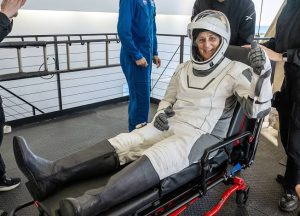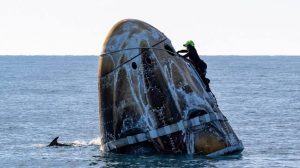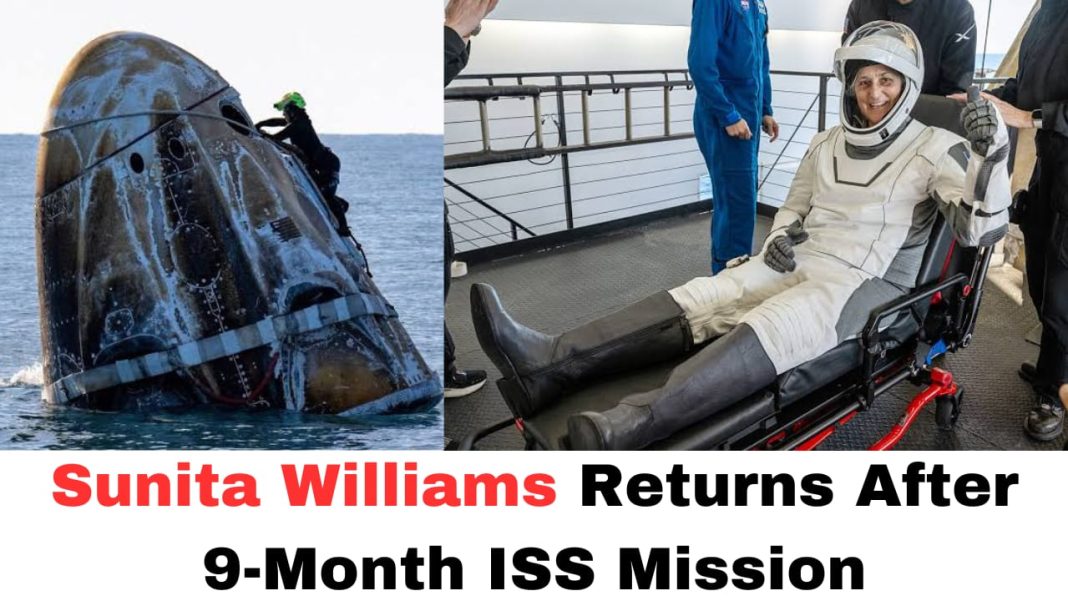Digital News Guru Current Affairs Desk:
After an unexpected nine-month sojourn aboard the International Space Station (ISS), NASA astronaut Sunita Williams has safely returned to Earth. Her mission, initially slated for just over a week, was extended due to unforeseen technical challenges, transforming it into a testament to human resilience and the spirit of international collaboration in space exploration.
Sunita Williams: A Space Icon
Sunita Williams, a retired U.S. Navy officer and astronaut, has had an extraordinary career with two long-duration space missions before this one. She first flew to space in 2006 aboard Space Shuttle Discovery and later returned in 2012 on a Russian Soyuz spacecraft.

She set records for female astronauts in extravehicular activities (EVAs). She has played a crucial role in space station maintenance, research, and outreach efforts, inspiring a new generation of astronauts worldwide.
Her latest mission was particularly significant as it involved important scientific experiments, spacecraft testing, and preparations for future lunar missions under NASA’s Artemis program.
The Prolonged Mission: From Days to Months
Williams, alongside fellow astronaut Barry “Butch” Wilmore, embarked on their mission with the expectation of a brief stay on the ISS. However, complications with the Boeing-developed Starliner spacecraft’s propulsion system rendered it unsafe for their return as planned. This unforeseen issue led to their integration into the regular ISS crew rotation, extending their mission to over nine months.
During this extended period, Williams and Wilmore adapted to their prolonged stay by engaging in various research projects, station maintenance tasks, and even conducting spacewalks. Their ability to adjust to the evolving mission parameters underscores the adaptability and dedication required of astronauts in the face of unexpected challenges.
The Return Journey: A Collaborative Effort
The culmination of this extended mission was marked by a successful return facilitated by SpaceX’s Crew Dragon spacecraft. The capsule, carrying Williams, Wilmore, astronaut Nick Hague, and Russian cosmonaut Aleksandr Gorbunov, executed a precise splashdown off the coast of Florida. This event not only highlighted the reliability of commercial spacecraft in ferrying astronauts but also emphasized the collaborative efforts between NASA and private aerospace companies like SpaceX.

Global Celebrations: Pride and Joy Across Continents
Williams’ safe return resonated globally, sparking celebrations that transcended borders. In her ancestral village of Jhulasan, Gujarat, India, residents rejoiced with traditional festivities, including prayers and cultural performances. The village, deeply proud of their connection to Williams, viewed her return as a moment of immense pride and inspiration.
Indian Prime Minister Narendra Modi acknowledged her achievements, highlighting the inspiration she provides to countless individuals in India and around the world. The Indian Space Research Organisation (ISRO) also lauded her dedication and the strengthening of ties between India and global space exploration efforts.
Impact on Women in STEM and Space Exploration
Sunita Williams has been an advocate for women in STEM (Science, Technology, Engineering, and Mathematics), often encouraging young girls to pursue careers in space exploration.
Her journey has inspired thousands of young women to take an interest in aerospace engineering, astrophysics, and space sciences. Programs like “Women in Space” by NASA and ISRO have gained momentum, promoting gender diversity in the field.
Her return and achievements serve as a reminder of the need for more female representation in STEM fields, encouraging governments and organizations to invest in educational programs that support young girls pursuing space-related careers.
The Broader Implications: A Testament to Human Ingenuity
Williams’ prolonged mission and safe return serve as a powerful reminder of human ingenuity and the collaborative spirit that drives space exploration. The successful adaptation to unforeseen challenges, the seamless cooperation between international space agencies and private companies, and the global celebrations of her return collectively highlight the unifying power of space exploration.

As we look to the future, Williams’ experience underscores the importance of flexibility, resilience, and international collaboration in overcoming the inherent uncertainties of space travel. Her journey not only adds a remarkable chapter to the annals of space exploration but also inspires future generations to reach beyond the stars, knowing that with determination and unity, even the most daunting challenges can be overcome.
Conclusion: A Star Who Continues to Shine
Sunita Williams’ return is not just a personal triumph—it is a symbol of human perseverance, scientific progress, and cross-cultural inspiration. Her journey, from a small village in Gujarat to commanding space missions, serves as a beacon of hope for aspiring astronauts worldwide.
As India and the world celebrate her achievements, one thing is certain: her story is far from over. With her vast experience and dedication, she will undoubtedly continue to shape the future of space exploration and inspire generations to come.
You May Also Read: 12 Indian Nationals Killed While Serving in Russian Army: A Heartbreaking Story








